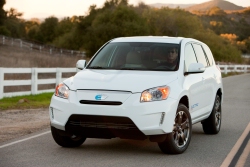Toyota driving toward 2012 hybrid vehicle onslaught

On the heels of reporting its latest corporate sustainability progress in North America, Toyota outlined some of its new innovation targets for eco-cars and next-generation electric vehicle battery research.
According to its latest plans, Toyota has 11 hybrid vehicle models planned for introduction by the end of 2012 (both new models and redesigned models). It plans a plug-in Prius hybrid vehicle introduction by the start of 2012, and it plans to bring the iQ "urban city car" to the United States, Europe and Japan in the same year. Road trials for the iQ are planned started in 2011.

For those who don't like to think small, the RAV4 EV electric concept car that Toyota is developing with Tesla Motors is on display at the Los Angeles Auto Show until the end of November. The second generation vehicle boasts a potential range of 100 miles.
Development is on-going for a sedan-style fuel-cell hybrid vehicle targeted for 2015. Toyota is also working on extending the performance of the batteries you might find in these vehicles, with an eye to exceeding the performance you might find with lithium-ion technology. It has about 100 people working on this challenge, both on solid-state batteries and on metal-air batteries.
The updates come on the heels of the publication of Toyota's 2010 North America Environmental Report issued earlier this week. The report details developments during the fiscal year ended March 2010. As you might imagine, many of the highlights are focused on reducing the impact of Toyota vehicles, not just in the ways described above with improvements in fuel efficiency and advanced vehicle technology, but also in terms of how vehicles are manufactured and how vehicle parts are recycled over their lifecycle.
Here's Toyota view on where it needs to focus:
"To achieve sustainable mobility, municipalities, state agencies, public transit authorities, urban planners, industry, community representatives and others have certain responsibilities in the mobility system must come together to forge a comprehensive vision and strategy to collectively reduce impacts over time. Toyota's primary responsibility in this effort is to provide technologically advanced vehicles to the marketplace that reduce environmental impacts, eventually replacing conventional automobiles. We do not believe that sustainable mobility will be achieve with a single technological solution, so we have undertaken a broad Comprehensive Environmental Technology (CET) approach to advanced vehicle technologies, with hybrids at the core."
As I picked through sections of the Toyota report, here are some highlights that caught my eye:
- Toyota's vehicles exceed the U.S. Corporate Average Fuel Economy (CAFE) standards for cars and light-duty trucks.
- Collectively, the company has reduced the amount of energy it takes to produce per vehicle in North America by 20 percent, compared with levels in 2000
- Toyota missed some of its recycling and resource management goals, such as its plan to recycle 75 percent of waste at the Toyota Motor Sales Headquarters and its focus on maintaining near-zero waste to landfill. But it is on track to reduce nonhazardous waste to landfill from U.S. North American Parts operations by 62 percent before fiscal year 2013.
- There was a 25 million gallon reduction in the use of potable water at Toyota's North America sales and distribution facilities
- The company now has five certified building in North America under the Leadership in Energy and Environmental Design (LEED) program. I also liked the fact that the company is encouraging this certification for dealerships. Apparently eight Toyota and Lexus dealerships are now LEED-certified, including one in Eugene, Oregon, that remains the only LEED Platinum dealership in the world.
This post was originally published on Smartplanet.com